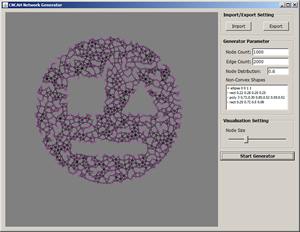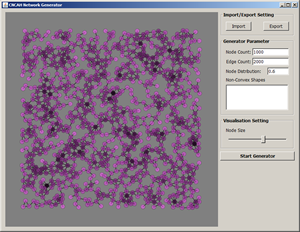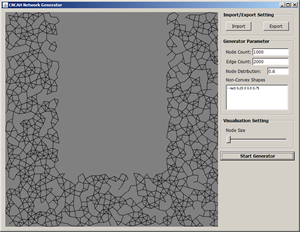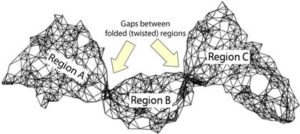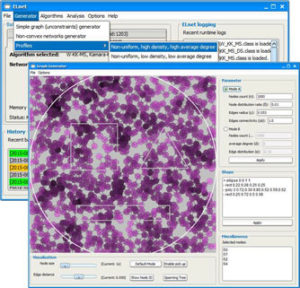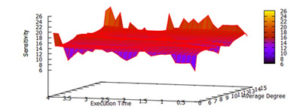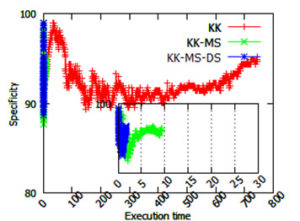Recent Posts
- Dataset of Visualization of Dynamic Graphs
- Online Force Directed Algorithms for Visualization of Dynamic Graphs
- Force-directed algorithms for schematic drawings and placement: A survey
- Snapshot Visualization of Complex Graphs with Force-directed Algorithms
- CWBound: boundary node detection algorithm for complex non-convex mobile ad hoc networks
Tags
CNCAHNetGenerator – CNCAH Network Generator
November 23, 2017 / Leave a comment
CNCAHNetGenerator is written in Java 7, to enable the creation of CNCAH networks of arbitrary node and edge types.
If you use CNCAH Network Generator for your research/development, please cite the following paper: Cheong, S.-H., Si, Y.-W., 2016. Accelerating the kamada-kawai algorithm for boundary detection in a mobile ad hoc network. ACM Transactions on Sensor Networks (TOSN) 13 (1), 3. Download EndNote Format (.enw), Download BibteX Format (.bib)
License & disclaimer
- CNCAHNetGenerator is freeware and under the LGPL License.
- You may not modify, reverse engineer, decompile, or disassemble the object code portions of this software.
- This software is provided “as is” and without any warranties expressed or implied, including, but not limited to, implied warranties of fitness for a particular purpose, and non-infringement. You expressly acknowledge and agree that use of the Software is at your sole risk.
- In no event shall the author be liable for any damages whatsoever (including, without limitation, damages for loss of business profits, business interruption, loss of business information, or other pecuniary loss) arising out of the use of or inability to use this software or documentation, even if the author has been advised of the possibility of such damages.
Download
Current: CNCAHNetGenerator version 0.1, from September 14, 2017.
Documentation
- CNCAHNetGenerator can generate CNCAH networks via the command line or the graphical interface. Example commands are shown in follows:
java -jar CNCAHNetGenerator.jar -help java -jar CNCAHNetGenerator.jar -n -v 1000 -e 4000 -o star -sf shapes\star.shape java -jar CNCAHNetGenerator.jar -n -v 1000 -e 4000 -o donut -sf shapes\donut.shape java -jar CNCAHNetGenerator.jar -n -v 1000 -e 4000 -o smile -sf shapes\smile.shape java -jar CNCAHNetGenerator.jar -n -v 1000 -e 4000 -o ushape -sf shapes\ushape.shape
Dataset of CNCAH Network
November 23, 2017 / Leave a comment
CNCAH shapes generated by the CNCAHNetGenerator. You can download the dataset from here. (more…)
Boundary node detection and unfolding of complex non-convex ad hoc networks
November 23, 2017 / Leave a comment
Complex non-convex ad hoc networks (CNCAH) contain intersecting polygons and edges. In many instances, the layouts of these networks are also not entirely convex in shape. In this paper, we propose a Kamada-Kawai based algorithm called W-KK-MS for boundary node detection problem, which is capable of aligning node positions while achieving high sensitivity, specificity and accuracy in producing a visual drawing from the input network topology. The algorithm put forward in this paper selects and assigns weights to top-k nodes in each iteration in order to speed up the updating process of nodes. We also propose a novel approach to detect and unfold stacked regions in CNCAH networks. Experimental results show that the proposed algorithms can achieve fast convergence on boundary node detection in CNCAH networks and are able to successfully unfold stacked regions. The design and implementation of a prototype system called ELnet for analyzing CNCAH networks is also described in this paper. The ELnet system is capable of generating synthetic networks for testing, integrating with force-directed algorithms, and visualizing and analyzing of algorithms’ outcomes.
The author’s version of a work that was accepted for publication can be downloaded from http://eric.lostcity-studio.com/wp-content/uploads/2019/08/Boundary-node-detection-and-unfolding-of-complex-non-convex-ad-hoc-networks.pdf. Se-Hang Cheong, and Yain-Whar Si. "Boundary node detection and unfolding of complex non-convex ad hoc networks" ACM Transactions on Sensor Networks (TOSN) 14.1 (2017): 1.
Accelerating the Kamada-Kawai algorithm for boundary detection in a mobile ad hoc network
November 23, 2017 / Leave a comment
Force-directed algorithms such as the Kamada-Kawai algorithm have shown promising results for solving the boundary detection problem in a mobile ad hoc network. However, the classical Kamada-Kawai algorithm does not scale well when it is used in networks with large numbers of nodes. It also produces poor results in non-convex networks. To address these problems, this paper proposes an improved version of the Kamada-Kawai algorithm. The proposed extension includes novel heuristics and algorithms that achieve a faster energy level reduction. Our experimental results show that the improved algorithm can significantly shorten the processing time and detect boundary nodes with an acceptable level of accuracy.
The author’s version of a work that was accepted for publication can be downloaded from Accelerating Kamada-Kawai for boundary detection in Mobile Ad-Hoc network. Se-Hang Cheong, and Yain-Whar Si. "Accelerating the Kamada-Kawai algorithm for boundary detection in a mobile ad hoc network." ACM Transactions on Sensor Networks (TOSN) 13.1 (2016): 3.
